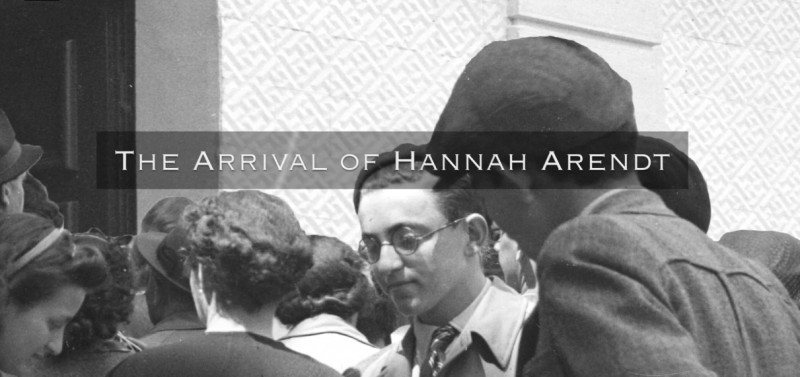
The Arrival of Hannah Arendt
This film describes the arrival of Hannah Arendt - a Jewish, German-American political theorist and publicist - in New York and her reflections on flight and helping people start over.

February 20, 1940
Mr. Rubin
I’ve noticed that people are different when they’re at home and when they’re at the Lublin Association. When he’s at the association, Mr. Rubin looks like everyone else. When he’s at home, he looks like the lord of the manor. He sits there with his cigar in his mouth giving me advice.
It’s impossible to get work at his glov faktoree, he said, because he can’t take on any more apprentices and there’s no other work for me to do there since I don’t speak English. Then he puffed on his cigar and four rings of smoke came out of it and Mr. Rubin came up with a plan for me: the best thing for a girl my age who comes to America…is to get married. „It’s harder for a girl to find work than to find a husband,“ he said. Mrs. Rubin mixed in and said, „What’s the matter with you? The girl needs a dzshob. What kind of advice is that to give a girl? Get married!“ I saw that Mrs. Rubin really was my mother’s friend and wanted to stand by me in these hard times.
Then Mr. Rubin took another drag on his cigar while I held my breath, and when he let out the rings of smoke, he offered a different suggestion. „Since the vice president of the Refugee Aid Society is from Lublin too, the best thing would be to go to him and have him figure out something for you to do. But in order for him to want to do anything, you need to bring him a letter from someone.“ Mr. Rubin thought about it for a long time. A letter from who? His cigar let out a few rings of smoke every now and then, and in the end, Mr. Rubin said, „Since Rabbi Finkel is also from Lublin, it would be best to get a letter from him. If the vice president gets a letter from Rabbi Finkel, he’ll have no choice but to do something on behalf of a refugee. How do you get a letter from Rabbi Finkel? Simple: you go get it. You don’t need connections in order to go see a rabbi.“ Mr. Rubin was sure that he had come up with the best plan, and he gave me adresses for Rabbi Finkel and for the president. (He must have a million addresses to give out.) He wrote each address on a separate piece of paper.
When I left their house, I felt as if finding work really was harder than finding a husband. The street was lively, with cars going in all directions, people rushing by, and crowds everywhere. It felt as if I needed to push all those people aside in order to find a place for myself, and then I could hurry off somewhere just like they were doing. My hands felt weak, and I was afraid that I’d never be able to push myself through.
When I came home and told my aunt about Mr. Rubin’s advice, she flicked it away with her hand and said, „Cold comfort, a cold fish. But still it’s worth a try.“
The author of the novel “A Jewish Refugee in New York” Kadya Molodovsky is one of the most important Yiddish poets of the mid-20th century. She was born in 1894 in Bereza Kartuska, Russian Empire and experienced the typical trajectory of Jewish migration of the 20th century: Odessa, Kyiv, Warsaw, New York, Tel Aviv. In the course of life she worked as a teacher, editor, poet, critic, playwright and writer. When World War I broke out, she worked in a day home for Jewish children who had fled, run by her teacher in Warsaw. She continued this work in various places until 1917. Later she moved to Odessa to escape the war front and worked in a kindergarten there. In 1917, after the October Revolution, she could not return to her parents, and so remained in Kyiv, where she again took a job as a kindergarten teacher. Surviving the pogrom in Kyiv in 1920, she published her first poem.
In 1935 she moved to New York, where she published her book “In Land fun Mayn Gebayn” (“In the Land of My Bones”). In it, she addresses the internalization of exile in fragmentary poems. From this point on, her work in New York flourished.
In her work “A Jewish Refugee in New York,” Kadya Molodowsky presents the life of Rivke Zilberg, a twenty-year-old refugee from Lublin in New York, in the form of a diary. Rivke Zilberg’s experiences have a certain similarity with Molodovsky’s fate. The diary covers such topics as: Flight, Holocaust, acculturation and more.
Kadya Molodovsky (translated by Anita Norich), 2019: A Jewish Refugee in New York. A Novel by Kadya Molodovsky. Bloomington: Indiana University Press, p. 16.